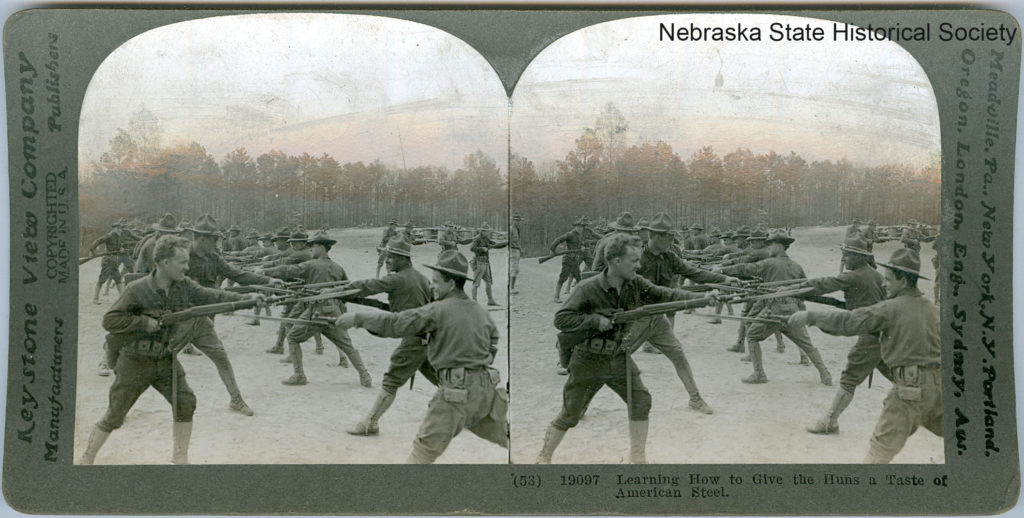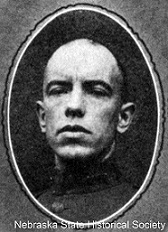 “If there is one thing the German fears more than anything else it is the bayonet charge,” wrote an employee of the Keystone View Company as part of a little essay on the back of this stereocard. The card’s caption reads, “Learning How to Give the Huns a Taste of American Steel.”
“If there is one thing the German fears more than anything else it is the bayonet charge,” wrote an employee of the Keystone View Company as part of a little essay on the back of this stereocard. The card’s caption reads, “Learning How to Give the Huns a Taste of American Steel.”
“These are the days that try men’s souls over here,” wrote U.S. Army First Lieutenant Harold Prince from a trench in France during World War I. “The nights are generally quiet,” Prince explained to his family back in Grand Island, Nebraska. “Then comes a crash of the big guns, but more ominous by far than that out of the quiet night comes the sinister ‘put-put-put-put’ of the machine guns. Then all is quiet again. Up goes a brilliant flame, again the ‘put-put-put-put’ of the machine gun, then quiet again. Such is the night. Then the daylight comes. Airplanes fly far overhead an occasional shell or two [is dropped], so it is day after day, night after night.”
 First Lieutenant Harold Prince of Grand Island. From A.F. Buechler, R.J. Barr, and Dale P. Stough, History of Hall County Nebraska (Lincoln: Western Publishing & Engraving Co., 1920), 540.
First Lieutenant Harold Prince of Grand Island. From A.F. Buechler, R.J. Barr, and Dale P. Stough, History of Hall County Nebraska (Lincoln: Western Publishing & Engraving Co., 1920), 540.
Prince explained that this was nature of battle for weeks on end,“no permanent change of important lines, then a push, a slaughter, a battle, a counter charge, until finally equilibrium is again established, quiet and peace again. Such is war on the front.” Prince, like so many other Grand Island men who served in World War I, recorded his experiences in letters home to friends, sweethearts, and family members. These letters tell the story of Grand Island and other Hall County servicemen’s wartime lives. Much of this correspondence appeared in the Grand Island Daily Independent, which published over two hundred letters from military personnel. Most of the men who authored the letters were from Grand Island, although a few letters were from rural or small-town Hall County men. These men’s friends and family members apparently simply brought the servicemen’s personal letters to the newspaper and the Daily Independent published them in the column “Letters from Our Lads on the Front.” The letters provide a window into the lives of Hall County military personnel in almost real time. Most were written within days or even hours of the events about which they comment so the memories and emotions were still fresh and sometimes raw. While the letters offer great insights into World War I military life, they also hold pitfalls for scholars. The letters are not without editing. At various points U.S. military personnel read and edited personal correspondence by enlisted men, removing any information that might give the enemy details about troop movements or strategy.
 This mask belonged to Elmer L. Bunger of Humboldt, Richardson County, a sergeant in Company E, 314th Supply Train of the 89th Division. Bunger participated in the St. Mihiel Offensive, Meuse-Argonne Offensive, and Lucey and Euvezin Sectors, and was honorably discharged on June 12, 1919.
This mask belonged to Elmer L. Bunger of Humboldt, Richardson County, a sergeant in Company E, 314th Supply Train of the 89th Division. Bunger participated in the St. Mihiel Offensive, Meuse-Argonne Offensive, and Lucey and Euvezin Sectors, and was honorably discharged on June 12, 1919.
This knowledge caused the doughboys to self-edit, fearing some information might not make it past the official censor. Many were also aware that the Daily Independent published military men’s letters and knew that their correspondence might appear in the newspaper. Some welcomed this publicity and appear to have written for public consumption. Others, knowing their letters might appear in the paper, may not have been as honest and forthcoming as they might have been in a truly private letter. Along with self-censoring, it is also possible that editing took place in Grand Island. Friends and family members may have removed parts of letters they considered too private to print. In some cases the editors of the Daily Independent omitted information. During the first weeks of the column, the paper published only extended excerpts from letters and in other cases information that the editors considered too sensitive was omitted. However, while some of the letters may have been altered, they still provide invaluable insights to Hall County doughboys’ wartime experiences. They reveal their bravado and fear, excitement and loneliness, and how they were changed by battle. To demonstrate their patriotism and loyalty more than 1,200 Hall County men were among the some four million Americans who served in the military during World War I. — Daryl Webb, Assistant Professor of History at Cardinal Stritch University in Milwaukee, Wisconsin Want to keep reading? For more excerpts from the Hall County soldiers’ letters as well as analysis of their motivations, successes, and tragedies, read “The Best War I Ever Expect to Have: Hall County Doughboys’ Letters Home” by Daryl Webb in the Spring 2016 edition of Nebraska History.




